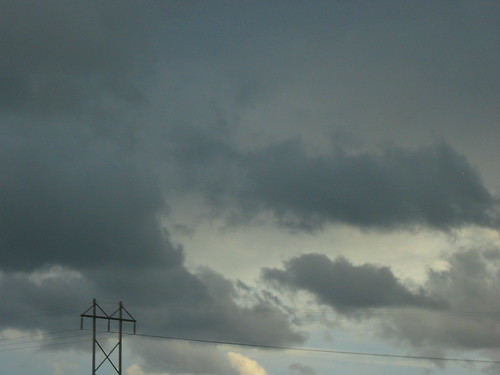
Some Clouds
Anxiety in the hock
shop retrieval: is that
the Marine Corps dress
blues jacket I left
under consignment at Aux
Puces circa 1969? Kierkegaard
writes: The doubter is
like a lash’d top.
He remains upright only
whilst the throttling continues,
unable to stand erect
without it. And Kafka
puts forth the necessity
of “a goal to
which one makes one’s
way by undergoing every
kind of unhappiness.” Weekend
of wheedling the Vibe
along the snowy roads,
keeping to the black
tracks of the eighteen
wheelers. Anxious, out of
angĕre to choke. Harold
Rosenberg in 1966:
To mention anxiety is to arouse suspicion of nostalgia or of a vested interest in the past, if not of a reactionary reversion to the middle class notion of genius suffering in a garret.Today one chokes on the preternatural un-troubledness of it all, the ease of its conveyance as it carries one exactly nowhere—just another rudimentary “construct,” a jalopy of cahoots. Rosenberg rightly insists that “the uneasiness of art in the face of its own situation was not adopted by artists as a manner, in the way that one adopts a leather jacket or a hairdo that covers the eyes”: “Anxiety was forced upon art as the experience that accompanies the rejection of shallow or fraudulent solutions.” And the ever-vacillatory Philip Guston, quoted in Dore Ashton’s Yes, but . . .: A Critical Study of Philip Guston:
I remember days of doing “pure” drawings immediately followed by days of doing the other—drawings of objects. It wasn’t a transition in the way it was in 1948, when one feeling was fading away and a new one had not yet been born. It was two equally powerful impulses at loggerheads. I would one day tack up in the house a bunch of pure drawings, feel good about them, think that I could live with them. And that night go out to the studio to the drawings of objects—books, shoes, buildings, hands, feeling relief and a strong need to cope with tangible things. I would denounce the pure drawings as too thin and exposed, too much “art,” not enough nourishment, and as an impossible direction with no future. The next day, or day after, back to doing the pure constructions and to attacking the other. And so it went, this tug-of-war, for about two years.To reject the merely processual, to re-insert the irreducibly human. Out of Bill Berkson’s terrific collection For the Ordinary Artist: Short Reviews, Occasional Pieces & More (BlazeVox, 2011), a piece call’d “From the Guston Papers”: “(To speak of stopping ‘when the emotion runs out.’)” And: “Dagwood’s Inferno.” And: “A cache of circumstances. Composition need not apply.” And:
Journal 3/11/61: “It’s like the fable of some last judgment. You want to say this is what I’ve done, good and bad, do you get it? But the line is so long you’ll never get to be judged anyway.” (P.G.) A visit to Philip Guston’s studio: weight in the air—different from the buzz or frenetic space of other painter’s lofts, and not exactly business-like as others’ beside, not oppressive either—the feeling you could talk there and, hearing what you’d say, you’d be surprised. INTEGRITY—in big block letters.How oddly that ancient human-sized bell sounds in the current “milieu.” Finally (“finally”?—a mustering of the inevitable is all one every manages), there’s Guston writing to poet and novelist and critic Ross Feld, included in the 1978 “Talk at ‘Art / Not Art?’ Conference” (out of Philip Guston: Collected Writings, Lectures, and Conversations):
“What’s wrong with feeling bad?” (P.G.)
I have recently done a painting which continues to baffle me, a highly desired state. I admit vacillating between trying to explain, or not to. Here are some thoughts then on a matter which should perhaps not be talked about at all. I also think the only real things to talk about are not possible to talk about. The painting might well say, “What do you want from me? I'm only a painting. Let me be.” . . . I know this may sound too circular, but it is here—precisely—where the mystifying area in creating enters. For, if, as I believe, one is changed by what one does—what one paints—continuous creation can be furthered only in time. That is, to maintain the condition of continuity—or as we might put it, the subversion of an intolerable finality. Not to do so would be to enter the wax-works museum, which is comic and hilarious—a sort of mock death. Further in refusing this wax-works state, one is propelled to make what one has not yet made, nor seen made. What one does not yet know how to make. I must say though, that to dwell overly much on this unknown character of time, in art, may be inutile. Perhaps we are not permitted to know more than we do know.(Rosenberg’s anxious art object talks, too: “Am I a masterpiece,” it must ask itself, “or an assemblage of junk?”) And “naturally” enough (though hardly invariably), we do know. Done with novelty-grabbing, aloft in the contingencies of brute history, sailing (wings unfetter’d by the kundalini upsurge of some kind of primal sap), we wring the human out of the veriest blue of the sky. Off days we “pioche away” with heads beneath blankets (a condition of our blackout and sour industry), formulaic, spading, mitigants to the pervasive restlessness amok partout.

William Gass Paint’d by Philip Guston

Philip Guston, “Painter’s Forms II,” 1978

Philip Guston, 1913–1980
(Photograph by Arthur Swoger)
(Photograph by Arthur Swoger)